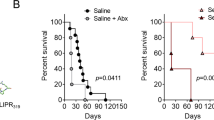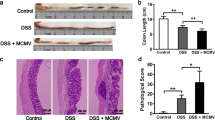Abstract
Objective
We questioned whether infection with murine gammaherpesvirus 68 (HV-68) might exacerbate inflammatory bowel disease using mice deficient in IL-10 (IL-10−/−) as a model of developing colitis.
Methods
Groups of C57BL/6 mice and IL-10−/− mice were mock-treated or infected with HV-68. Two months following infection, mice were euthanized and a variety of parameters were measured to quantify the extent of inflammation and the presence of virus. Measurements included survival, body weight, splenomegaly, colonic disease scores, liver histopathology, viable bacteria in the liver, and splenic viral burden.
Results
IL-10−/− mice infected with HV-68 displayed reduced survival, lower body weights, increased splenomegaly, exacerbated colonic disease scores, increased numbers of viable bacteria in the liver, and increased leukocyte liver infiltration when compared to mock-treated IL-10−/− mice or HV-68 infected C57BL/6 mice. Surprisingly, levels of infectious or latent virus were not significantly different between the groups of mice exposed to HV-68.
Conclusions
The presence of HV-68 in IL-10−/− mice exacerbates the developing clinical disease in this animal model of colitis.







Similar content being viewed by others
References
Lunemann JD, Munz C. Epstein–Barr virus and multiple sclerosis. Curr Neurol Neurosci Rep. 2007;7(3):253–8.
Niller HH, Wolf H, Minarovits J. Regulation and dysregulation of Epstein–Barr virus latency: implications for the development of autoimmune diseases. Autoimmunity. 2008;41(4):298–328.
Peacock JW, Elsawa SF, Petty CC, Hickey WF, Bost KL. Exacerbation of experimental autoimmune encephalomyelitis in rodents infected with murine gammaherpesvirus-68. Eur J Immunol. 2003;33(7):1849–58.
Harley JB, Harley IT, Guthridge JM, James JA. The curiously suspicious: a role for Epstein–Barr virus in lupus. Lupus. 2006;15(11):768–77.
Costenbader KH, Karlson EW. Epstein–Barr virus and rheumatoid arthritis: is there a link? Arthritis Res Ther. 2006;8(1):204.
Nikolich-Zugich J. Ageing and life-long maintenance of T-cell subsets in the face of latent persistent infections. Nature Rev. 2008;8(7):512–22.
Saygun I, Kubar A, Sahin S, Sener K, Slots J. Quantitative analysis of association between herpesviruses and bacterial pathogens in periodontitis. J Periodontal Res. 2008;43(3):352–9.
Slots J. Herpesviruses, the missing link between gingivitis and periodontitis? J Int Acad Periodontol. 2004;6(4):113–9.
Slots J. Herpesviral-bacterial synergy in the pathogenesis of human periodontitis. Curr Opin Infect Dis. 2007;20(3):278–83.
Brook I. The association of anaerobic bacteria with infectious mononucleosis. Anaerobe. 2005;11(6):308–11.
Stenfors LE, Bye HM, Raisanen S, Myklebust R. Bacterial penetration into tonsillar surface epithelium during infectious mononucleosis. J Laryngol Otol. 2000;114(11):848–52.
Stenfors LE, Bye HM, Raisanen S. Causes for massive bacterial colonization on mucosal membranes during infectious mononucleosis: implications for acute otitis media. Int J Pediatr Otorhinolaryngol. 2002;65(3):233–40.
Garimorth K, Kountchev J, Bellmann R, Semenitz B, Weiss G, Joannidis M. Lemierre’s syndrome following infectious mononucleosis. Wien Klin Wochenschr. 2008;120(5–6):181–3.
Givner LB. Arcanobacterium haemolyticum sepsis and Epstein–Barr virus infection. Pediatr Infect Dis J. 1992;11(5):417–8.
Yoon TY, Yang TH, Hahn YS, Huh JR, Soo Y. Epstein–Barr virus-associated recurrent necrotic papulovesicles with repeated bacterial infections ending in sepsis and death: consideration of the relationship between Epstein–Barr virus infection and immune defect. J Dermatol. 2001;28(8):442–7.
Bertalot G, Villanacci V, Gramegna M, Orvieto E, Negrini R, Saleri A, et al. Evidence of Epstein–Barr virus infection in ulcerative colitis. Dig Liver Dis. 2001;33(7):551–8.
Kangro HO, Chong SK, Hardiman A, Heath RB, Walker-Smith JA. A prospective study of viral and mycoplasma infections in chronic inflammatory bowel disease. Gastroenterology. 1990;98(3):549–53.
Spieker T, Herbst H. Distribution and phenotype of Epstein–Barr virus-infected cells in inflammatory bowel disease. Am J Pathol. 2000;157(1):51–7.
Takeda Y, Takada K, Togashi H, Takeda H, Sakano M, Osada Y, et al. Demonstration of Epstein–Barr virus localized in the colonic and ileal mucosa of a patient with ulcerative colitis. Gastrointest Endosc. 2000;51(2):205–9.
Van Kruiningen HJ, Poulin M, Garmendia AE, Desreumaux P, Colombel JF, De Hertogh G, et al. Search for evidence of recurring or persistent viruses in Crohn’s disease. Apmis. 2007;115(8):962–8.
Wakefield AJ, Fox JD, Sawyerr AM, Taylor JE, Sweenie CH, Smith M, et al. Detection of herpesvirus DNA in the large intestine of patients with ulcerative colitis and Crohn’s disease using the nested polymerase chain reaction. J Med Virol. 1992;38(3):183–90.
Yanai H, Shimizu N, Nagasaki S, Mitani N, Okita K. Epstein–Barr virus infection of the colon with inflammatory bowel disease. Am J Gastroenterol. 1999;94(6):1582–6.
Cohen JI. Epstein–Barr virus infection. N Engl J Med. 2000;343(7):481–92.
Compston LI, Sarkobie F, Li C, Candotti D, Opare-Sem O, Allain JP. Multiplex real-time PCR for the detection and quantification of latent and persistent viral genomes in cellular or plasma blood fractions. J Virol Methods. 2008;151(1):47–54.
Cameron B, Bharadwaj M, Burrows J, Fazou C, Wakefield D, Hickie I, et al. Prolonged illness after infectious mononucleosis is associated with altered immunity but not with increased viral load. J Infect Dis. 2006;193(5):664–71.
Hislop AD, Taylor GS, Sauce D, Rickinson AB. Cellular responses to viral infection in humans: lessons from Epstein–Barr virus. Annu Rev Immunol. 2007;25:587–617.
Doherty PC, Tripp RA, Hamilton-Easton AM, Cardin RD, Woodland DL, Blackman MA. Tuning into immunological dissonance: an experimental model for infectious mononucleosis [see comments]. Curr Opin Immunol. 1997;9(4):477–83.
Flano E, Woodland DL, Blackman MA. A mouse model for infectious mononucleosis. Immunol Res. 2002;25(3):201–17.
Mistrikova J, Raslova H, Mrmusova M, Kudelova M. A murine gammaherpesvirus. Acta Virol. 2000;44(3):211–26.
Simas JP, Efstathiou S. Murine gammaherpesvirus 68: a model for the study of gammaherpesvirus pathogenesis. Trends Microbiol. 1998;6(7):276–82.
Elsawa SF, Bost KL. Murine gamma-herpesvirus-68-induced IL-12 contributes to the control of latent viral burden, but also contributes to viral-mediated leukocytosis. J Immunol. 2004;172(1):516–24.
Elsawa SF, Taylor W, Petty CC, Marriott I, Weinstock JV, Bost KL. Reduced CTL response and increased viral burden in substance P receptor-deficient mice infected with murine gamma-herpesvirus 68. J Immunol. 2003;170(5):2605–12.
Gasper-Smith N, Marriott I, Bost KL. Murine gamma-herpesvirus 68 limits naturally occurring CD4+CD25+T regulatory cell activity following infection. J Immunol. 2006;177(7):4670–8.
Gasper-Smith N, Singh S, Bost KL. Limited IL-6 production following infection with murine gammaherpesvirus 68. Arch Virol. 2006;151(7):1423–9.
Peacock JW, Bost KL. Infection of intestinal epithelial cells and development of systemic disease following gastric instillation of murine gammaherpesvirus-68. J Gen Virol. 2000;81(Pt 2):421–9.
Peacock JW, Bost KL. Murine gammaherpesvirus-68-induced interleukin-10 increases viral burden, but limits virus-induced splenomegaly and leukocytosis. Immunology. 2001;104(1):109–17.
Bhan AK, Mizoguchi E, Smith RN, Mizoguchi A. Colitis in transgenic and knockout animals as models of human inflammatory bowel disease. Immunol Rev. 1999;169:195–207.
Kuhn R, Lohler J, Rennick D, Rajewsky K, Muller W. Interleukin-10-deficient mice develop chronic enterocolitis. Cell. 1993;75(2):263–74.
Powrie F, Uhlig H. Animal models of intestinal inflammation: clues to the pathogenesis of inflammatory bowel disease. Novartis Found Symp. 2004;263:164–74. discussion 74-8, 211-8.
Berg DJ, Davidson N, Kuhn R, Muller W, Menon S, Holland G, et al. Enterocolitis and colon cancer in interleukin-10-deficient mice are associated with aberrant cytokine production and CD4(+) TH1-like responses. J Clin Invest. 1996;98(4):1010–20.
Dutia BM, Allen DJ, Dyson H, Nash AA. Type I interferons and IRF-1 play a critical role in the control of a gammaherpesvirus infection. Virology. 1999;261(2):173–9.
DeMeo MT, Mutlu EA, Keshavarzian A, Tobin MC. Intestinal permeation and gastrointestinal disease. J Clin Gastroenterol. 2002;34(4):385–96.
Karlinger K, Gyorke T, Mako E, Mester A, Tarjan Z. The epidemiology and the pathogenesis of inflammatory bowel disease. Eur J Radiol. 2000;35(3):154–67.
Swidsinski A, Lee SP. The role of bacteria in gallstone pathogenesis. Front Biosci. 2001;6:E93–103.
Zeuzem S. Gut-liver axis. Int J Colorectal Dis. 2000;15(2):59–82.
Kennedy RJ, Hoper M, Deodhar K, Erwin PJ, Kirk SJ, Gardiner KR. Interleukin 10-deficient colitis: new similarities to human inflammatory bowel disease. Br J Surg. 2000;87(10):1346–51.
Madsen KL. Inflammatory bowel disease: lessons from the IL-10 gene-deficient mouse. Clin Invest Med. 2001;24(5):250–7.
Rennick DM, Fort MM. Lessons from genetically engineered animal models. XII. IL-10-deficient (IL-10(−/−) mice and intestinal inflammation. Am J Physiol Gastrointest Liver Physiol. 2000;278(6):G829–33.
Brimnes J, Reimann J, Nissen M, Claesson M. Enteric bacterial antigens activate CD4(+) T cells from scid mice with inflammatory bowel disease. Eur J Immunol. 2001;31(1):23–31.
Madsen KL, Doyle JS, Tavernini MM, Jewell LD, Rennie RP, Fedorak RN. Antibiotic therapy attenuates colitis in interleukin 10 gene-deficient mice. Gastroenterology. 2000;118(6):1094–105.
Sellon RK, Tonkonogy S, Schultz M, Dieleman LA, Grenther W, Balish E, et al. Resident enteric bacteria are necessary for development of spontaneous colitis and immune system activation in interleukin-10-deficient mice. Infect Immun. 1998;66(11):5224–31.
Takahashi I, Matsuda J, Gapin L, DeWinter H, Kai Y, Tamagawa H, et al. Colitis-related public T cells are selected in the colonic lamina propria of IL-10-deficient mice. Clin Immunol. 2002;102(3):237–48.
Author information
Authors and Affiliations
Corresponding author
Additional information
Responsible Editor: S. Stimpson.
Rights and permissions
About this article
Cite this article
Nelson, D.A., Petty, C.C. & Bost, K.L. Infection with murine gammaherpesvirus 68 exacerbates inflammatory bowel disease in IL-10-deficient mice. Inflamm. Res. 58, 881–889 (2009). https://doi.org/10.1007/s00011-009-0059-x
Received:
Revised:
Accepted:
Published:
Issue Date:
DOI: https://doi.org/10.1007/s00011-009-0059-x




